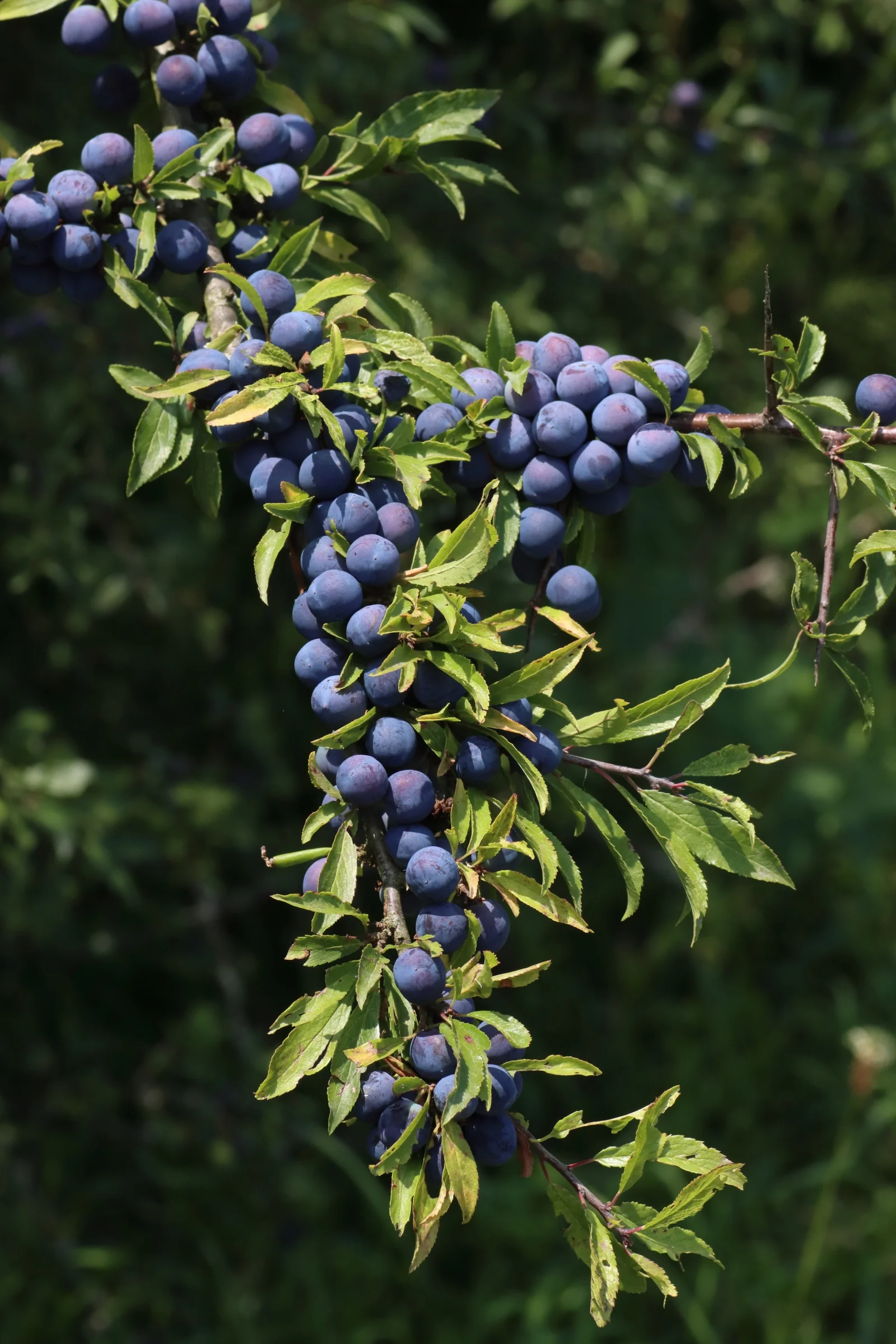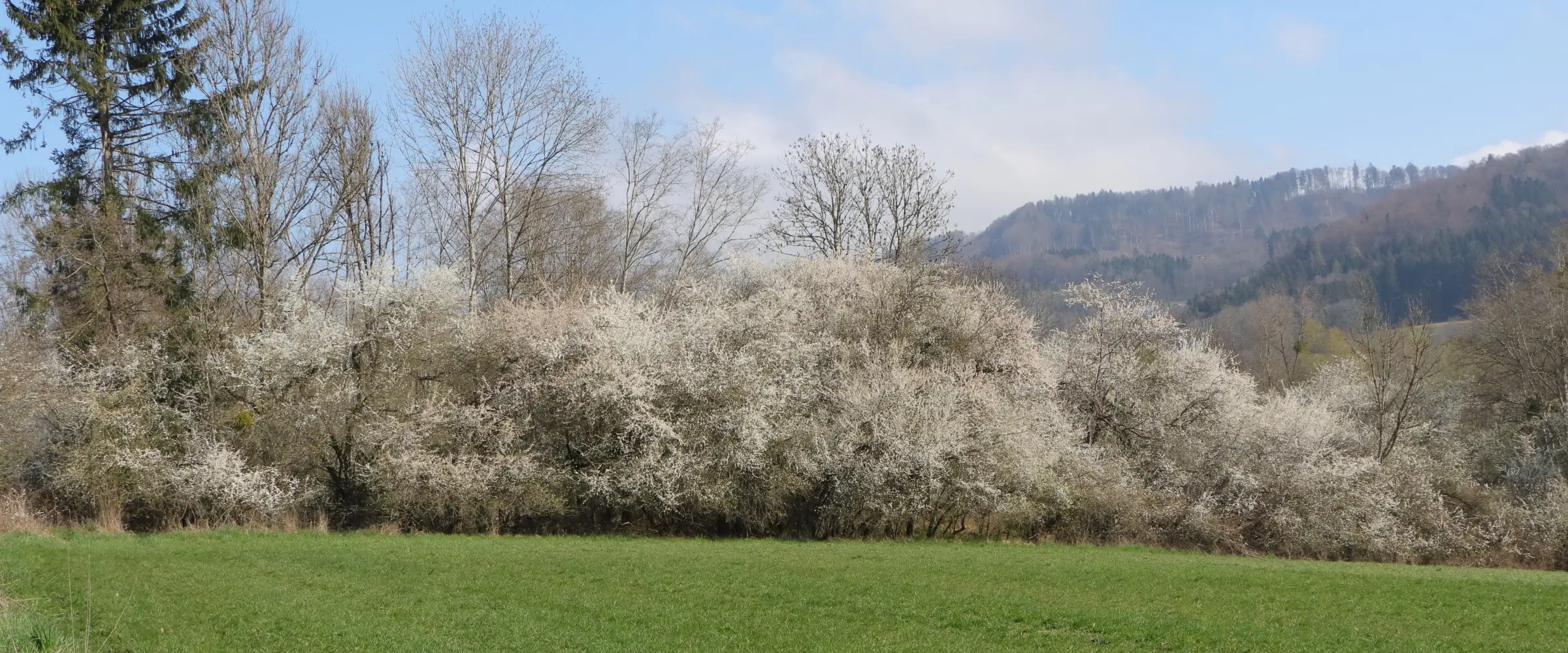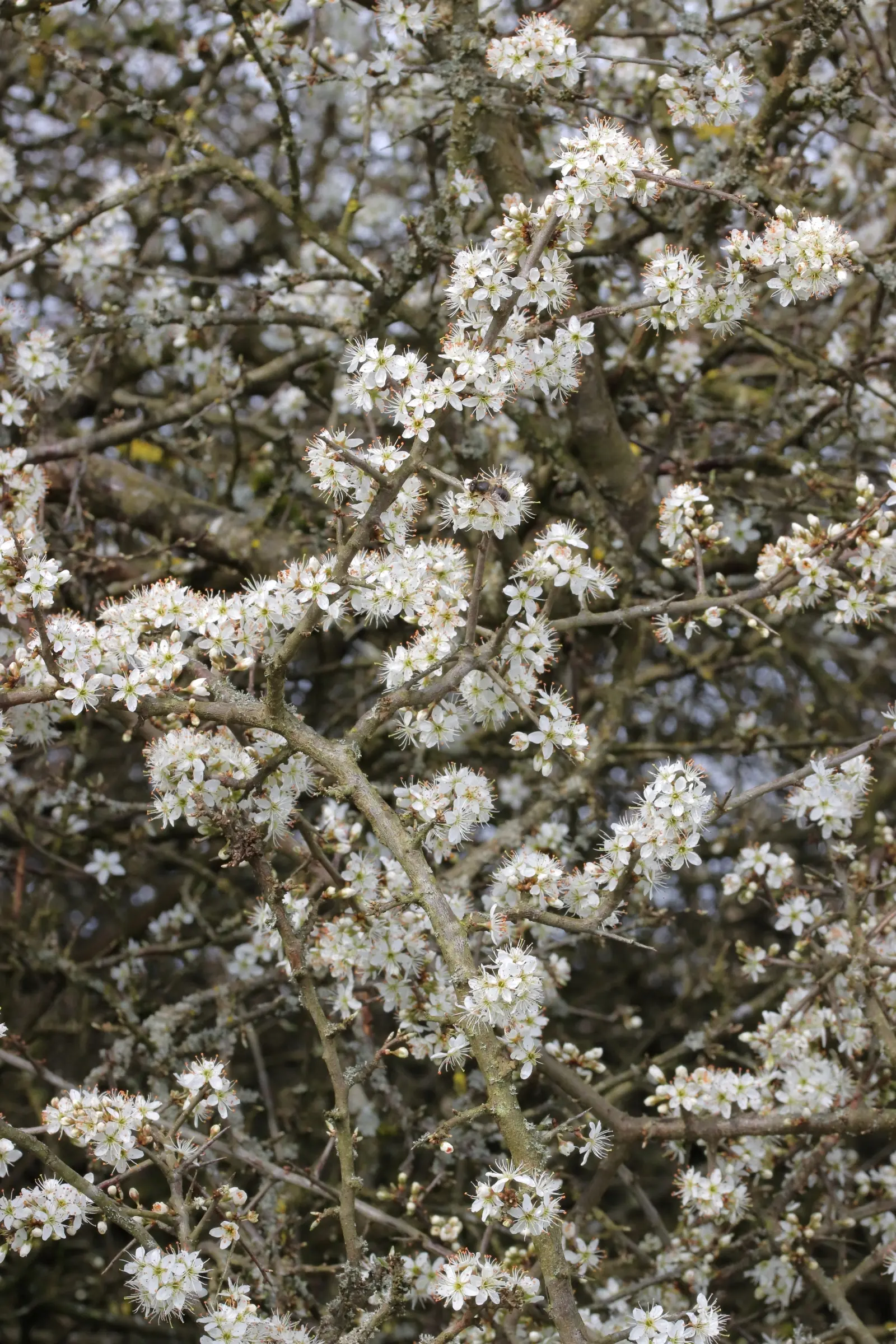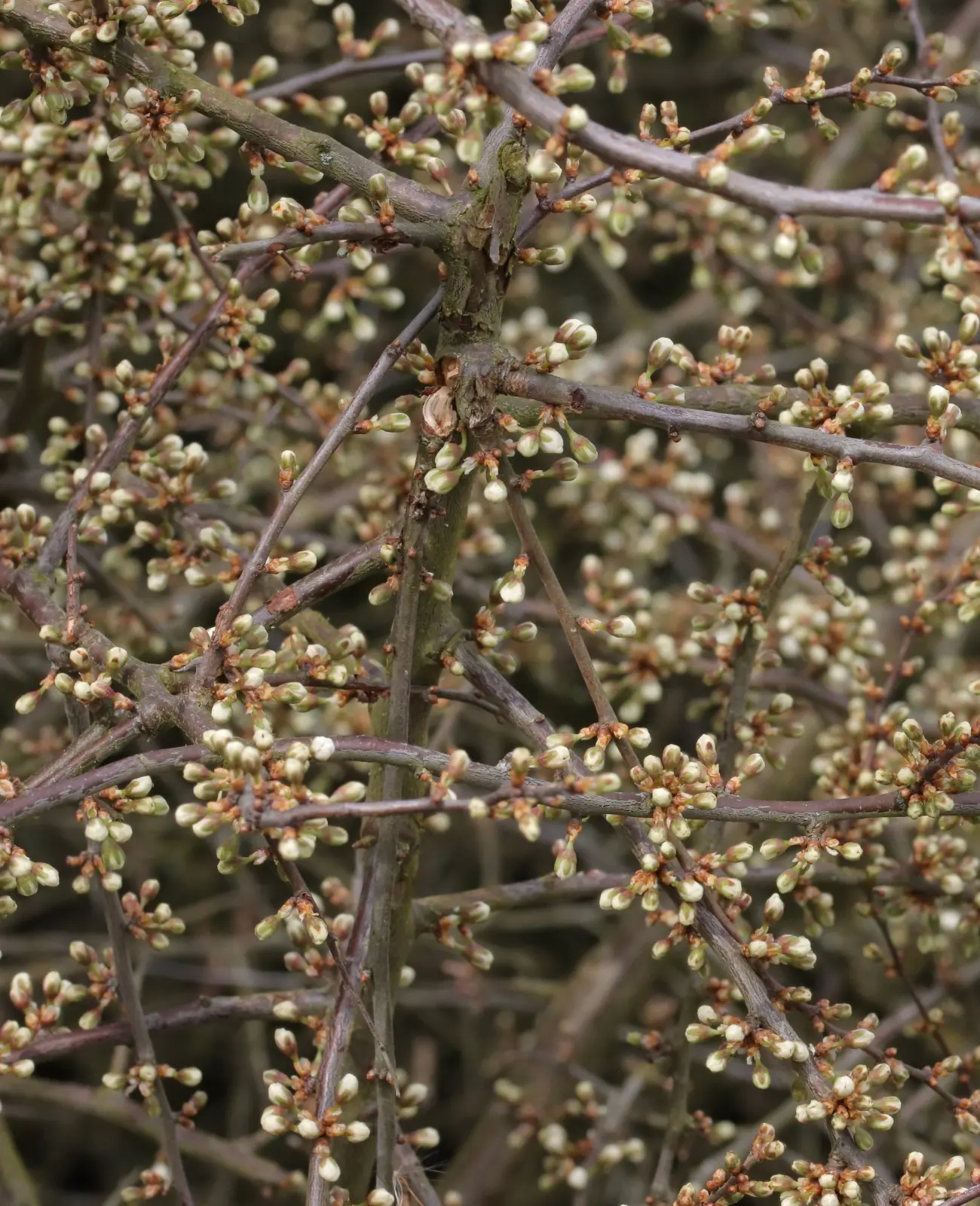The white flowers of the “Blackthorn” (Prunus spinosa) are among the first splashes of colour in the hedges in spring. In autumn, the dark blue fruits form on the branches.


Occurrence and distribution: Blackthorn grows mainly in sunny hedgerows, on woodlands and waysides as well as on rocky slopes. The plant prefers a nutrient-rich, calcareous and stony soil. It is naturally distributed throughout Europe, the Near East to the Caucasus and in North Africa. In North America and New Zealand, the plant is considered a neophyte. Blackthorn is a heat-loving woody plant and is therefore only found in the Alps at altitudes of up to 1,000 metres.
Plant description
Growth habit: The blackthorn has a shrub-like growth habit and can reach a height of up to 3 metres (in rare cases up to 6 metres – under good conditions). Individual plants can live up to 40 years. At a later age, blackthorn can acquire a “tree-like growth” – they then often have “several trunks”.
Leaves: The plant is deciduous. The leaves have an elongated to ovoid leaf shape and can reach a length of between two and four centimetres. The leaf veins are clearly visible on the upper and lower sides. On the upper side of the leaves they have a light green to dark green colour.
Flowers: A large number of white flowers form on the branches. They are on short stems, close to the branches. The individual flowers consist of five petals and have 7 to 20 white stamens with orange anthers. In the centre of the flower is the yellow-green coloured pistil, which sits on a long stalk. The five short bracts as well as the petals are of the same colour. Pollination is mainly done by bees, bumblebees and other Hymenoptera. The flowering period is from March to May.
Fruits: The fruits of the blackthorn are roundish and have a dark blue / black-blue colouring (if they are ripe). At first the fruits have a green colour, which later changes to blue. They have a tart and sour taste and can only be used after several days of frost. The fruits are considered “stone fruits” because the skin and the core are hard and are surrounded by a flesh. The flesh is light yellow to orange in colour.

Special characteristics of the plant
Special characteristics of the plant: The stems and branches are covered with many individual thorns. These converge at the end and have a rounded shape. It should be noted that these are not thorns in the true sense. They are transformed side shoots. The entire plant is clearly branched – these often stand out at a 90° angle from the main branches. The bark is light grey to black in colour. When young the branches are still smooth, older branches have rough bark. An extensive root network with shallow roots forms below the ground (shallow rooter). The underside of the older leaves is bare in contrast to the young leaves.
Spreading of the plant: The plant spreads mainly by root runners (root sprouts) and by birds. These eat the fruits and excrete the seed undigested in another place.
Special features of the flowers: The small, brown (pointed tapering) buds form already in winter. The brown-coloured bud scales burst open before flowering, revealing the white petals. They are usually slightly hairy. The flowers have a sweet fragrance.
Special features of the fruits: The fruits have a light wax coating on the surface. This causes them to reflect the UV light, which is a signal for birds. The fruits are thus eaten more often and the undigested stone seeds can be spread over long distances. More than 20 different bird species and some animals contribute to the dispersal of the seeds.


Leaves as caterpillar food & flowers as nectar supplier
Leaves as caterpillar food: The leaves are particularly tasty for the caterpillars of the blackthorn moth. These can “eat” an entire blackthorn bush bare. However, the caterpillars of the plum dwarf moth, the sloe moth and the blackthorn moth also use the leaves of the sloe as caterpillar food. All these species belong to the group of moths. Of the day butterflies, the glider butterfly is probably the best known “sloe eater”. A total of over 113 different butterfly species can be found on the sloe.
Flowers as a source of nectar: The flowers serve as a source of nectar for butterfly species that fly early in the year, such as the peacock butterfly, comma butterfly, cosmopolitan butterfly, large and small fox, as well as the map butterfly.
Use of the bark
Use of the bark: In the Middle Ages, the bark was used to make a reddish-brown ink, among other things. This was known as “briar ink”. A recipe for the production of the ink is found in Quellenschriften für Kunstgeschichte und Kunsttechnik des Mittelalters und der Renaissance – Schedula diversarum artium by Theophilus, Presbyter, 12. century; translated by Ilg, Albert; Hagen, Hermann, Wien 1874, page 90 – 93.
Recipe from the book (slightly modified for better clarity): For this, the “thorny branches” – twigs of blackthorn – were cut in April to May and dried for a few days. The bark was removed and put in water. This mixture was also left to stand for a few days until the water had turned reddish brown. This mixture was boiled until all the dye from the bark was transferred to the water. The brew was then boiled with wine and thickened with tree resin if necessary and then dried to a powder. The mixture was dissolved with warm wine for use as ink.
Use of the other parts of the plant
Use of the thorns: In the Swabian Alb, the thorns of the blackthorn were collected before Christmas and dried on the stove. They were then used to seal sausages. – Source: Book “Swabian Flora” by the Swabian Alb Association.
Use of the fruits: After the fruits become edible through frost, the blue-black fruits can be harvested. The pulp (without the skin) is used to make liqueurs, jams and tinctures, among other things. The puree / jam can be used, among other things, for loss of appetite.
Use of the wood for the production of shillelaghs: The so-called “shillelaghs” are made from the wood and the root of the blackthorn, especially in Ireland. This is a thorn-covered, wooden stick / club made from a bony piece of the blackthorn and a piece of the root as a pommel. Originally, shillelaghs were probably very commonly used as tools by Irish fishermen. The traditional production of the sticks and clubs is done by smoking (this also results in the dark / black colouring, which is typical for the sticks).
Use of the plant by animals
Use of the plant by the red-backed shrike: The long spines of the blackthorn are partly used by the red-backed shrike (a bird species). Here the bird “impales” its prey on the spines for later use. Another interesting feature of the blackthorn is that it also serves as a nesting site for the red-backed shrike. Here, the nests are made by the birds in the very prickly shrubs. The barred warbler (a bird species) also benefits from being in the neighbourhood of the red-backed shrike. Unlike other birds, they are not influenced by the territorial behaviour of the red-backed shrike (they are apparently not seen as a threat) and can therefore also nest in the blackthorn.
Folkloric use of the plant
Folkloric use of the plant: In folk medicine, the flowers are used to make a blood-purifying tea. They also have a laxative and diuretic effect. In the case of coughs, the tea promotes expectoration and can also be used as a gargle against throat complaints. The very sour juice of the fruits can be used for colds. However, the fruits can only be used after a few nights of frost, as this reduces the bitter-tasting tannins in the fruits.
Folk names
Folk names: Blackthorn is known by many different folk names. The most important include “Schlehdorn, Schwarzdorn” or also “Schleh / Schleie” (especially in the Swabian Alb). The name “Schwarzdorn” (blackthorn) is derived from the Latin term “spina nigra” (black thorns). Botanist Marzell explains that it could probably derive from the branches turning black with age (in contrast to the hawthorn). However, a definitive answer cannot be given. The popular name “Schlehdorn” refers to the numerous, large spines on the branches of the plant. In English, the plant is called “blackthorn”. Here, too, one can see the connection to the black-coloured branches and thorns. The fruits are called “sloe”.
The lesser known popular names include Kietschke Pflaume, Saudorn, Haferschlehe and Bockbeerli. A lesser known name “Saudorn” can be explained by the sour fruits of the blackthorn. This is because the addition “Sau- / Roß- or Hunds-” is used for many plants as a reference to the inedibility of the plant. See also “Origin of the botanical name of black henbane” – found here: Black henbane on Blumen-Natur.de. The name Haferschlehe is a name for the hybrid species “Prunus x fruticans”, which is said to have arisen from the common blackthorn and bullace (Prunus domestica var. insititia).
Name origin
Name origin: The botanical genus name “Prunus” is given to all plums, cherries, peaches and almonds, as well as similar plants that originate from this genus. The word is derived from the Latin “prunus” – meaning “plum”. This in turn can be derived from the Greek προῦμνον (proumnon) or προῦμνος (proumnos). Most of the associated plants have a similar appearance to the plum (by colour or appearance). The botanical species name “spinosa” can be translated into German as “thorny, prickly”. This refers to the long spines of the shrub.
The German name “Schlehe” is believed to originate from the Old High German / Germanic word “slewa / slēha” which can be translated into modern German as “blue-black”. The Middle High German word “slehe” is said to be a variation of these words. A possible relationship to the Latin words “lividus” – meaning “bluish” or “livor” – meaning “bluish colour” or “livēre” – meaning “to be bluish” is also worth mentioning here (fief words).
Another possibility is the relationship with the Upper German (South German) word “schlähe” which can be related to “tart” – from the tart taste of the fruits. A detailed analysis of the origin of the name can be found in the book “Deutschen Wörterbuch von Jacob Grimm und Wilhelm Grimm” and in “Graeca-Latina” by Ernst Fraenkel in the journal Glotta, 4th vol., 1st/2nd ed. (1913), page 38. In many eastern languages (Czech, Polish, Russian, Serbian, Slovenian) the plant is known under the name “sliva” – in german: Pflaume / english: plum.
German folklore around the blackthorn
Mythology surrounding the plant: According to an old legend, the buckthorn once accused the blackthorn in front of the other trees of giving its branches for the crown of thorns of Christ. Then God had mercy on the blackthorn and gave it thousands of white blossoms in spring as a sign of innocence. This is the so-called “Schleiebluscht” (sloe blossom). The word “bluscht” means as much as blossom of trees or bushes and is derived from the Middle High German word “bluost”. Blackthorn is also said to be safe from thunderstorms and lightning (please do not try this yourself, as it can be struck by lightning like any other tree/shrub). – Source: Book “Swabian Flora” by the Schwäbischer Albverein.
Customs surrounding the plant: In former times, blackthorn was considered a “weather and harvest plant”. Thus, the days between the sloe blossom and 23. April – Georgi Day – were counted (in 2023 on Lake Constance, for example, this would be: 08 April to 23 April = 16 days). This was then used to determine the exact harvest day of the grain around St. Jacob’s Day (25 July). – Source: Book “Swabian Flora” by the Schwäbischer Albverein.
German mythology around the plant
Protection against evil spells and witches: The thorny branches were said to have a strong protective effect against evil spirits and witches. On Walpurgis Night (30 April), blackthorn branches are nailed to the stable doors or stuck in the dung heap. This protects the cattle and the farmer against all kinds of witchcraft. Sometimes pieces of blackthorn were sewn into the dress to protect against evil spells. Men always carried a blackthorn stick with them (the plant was also a popular wood for making walking sticks and shepherd’s crooks). – Source: Book “Schwäbische Flora” by the Schwäbischer Albverein.
Blackthorn as a border tree to the Otherworld: According to ancient belief, by sleeping under the blackthorn, one should be able to pass the border to the “Otherworld” in a dream. It is therefore considered a “threshold plant”.
Irish Mythology and the Blackthorn
Blackthorn in Irish mythology: In Irish / Scottish mythology, the “Cailleach” (Gaelic mythical figures from Scotland, Ireland and the Isle of Man – literally: old woman – goddess of winter) has a stick made of “blackthorn” (sloe). The “Cailleach figures” are often described as witch-like female giants and are said to be associated with the weather (and the season of winter). Blackthorn is also regarded as a “witch tree”.
The Blackthorn and Fairies: There are various regional superstitions about this. According to Irish folklore, the flowers are supposed to be protected by fairies who are not kind to people – are regarded as evil fairies – the so-called “guardian fairies Lunantishee” (protectors of the plant). These fairies only leave the plant on the full moon (Esbats). At these times it was said to be safe for the people to harvest the plants or collect the wood.
Bad luck from the blackthorn? Gaelic Faith and Christian Traditions
Bad luck caused by the blackthorn: In Ireland, cutting the plant was associated with “bad luck”. For the flowering branches were not to be brought home. Under no circumstances should the flowering branches be brought into a church.
This custom arose from the fact that Ireland was the first European country to become Christian. The Christian customs and traditions therefore had to assert themselves against the old Druidic traditions, which were vehemently carried on especially by the common people.
It is also possible that the fact was exploited that sloe was already associated with the goddess Mòrrìgan in the Druidic tradition. In the Gaelic tradition, she was regarded as a goddess of war and disaster. This also provides a possible explanation as to why the myths surrounding the sloe only exist in the Irish/Scottish region and not in the rest of Europe. There, the Roman Empire already had considerably more influence, even in the preceding centuries.
In an old Christian belief, the blackthorn is also said to have been used for Jesus’ crown of thorns. Jesus is said to have been given a crown of thorns made of “sloe wood” when he was crucified. Unfortunately, this theory cannot be proven, as sloes are not represented in the Middle East.
Blackthorn and the Christian Faith
Use of sloe wood in “magic wands”: According to Christian belief, the early “witches and wizards” used the plant to make “magic wands” and for black magic. This was probably a “misattribution”, as a confusion with the shillelaghs (black coloured walking sticks / clubs) seems very likely. Originally, the shillelaghs were probably very often used as tools by Irish fishermen. As they were sometimes short in length, there may have been some connection with “magic wands” by the Christians. However, there is no clear evidence of this.
Blackthorn as a devil plant: The plant was also associated with Gaelic beliefs. Therefore, it is said to have been regarded as a devil plant in former times, as a pact with the devil could be made if one pricked oneself with the thorns of the plant. According to today’s knowledge, this is to be regarded as a “misbelief” and can probably also be interpreted as a Christian campaign against the ancient beliefs of the early Irish.
The blackthorn and the ‘witch panic’: In Great Britain, as well as in many other European countries, there was a so-called ‘witch panic’ in the early modern period (around 1450 to 1750). This meant that people who possessed a ‘black rod’ (a carved stick made of sloe with spikes on the end) were regarded as “troublemakers / witchers”.
Endangerment of the plant
Endangerment of the plant: The blackthorn is classified as not endangered on the German Red List. It is also considered to be endangered in the individual federal states.
Distribution codes: A, AV, M1, M2, F, K